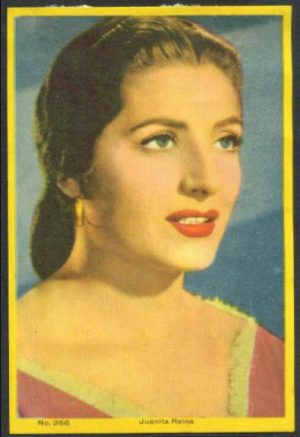Juanita Reina Death
Juanita passed away on March 19, 1999 at the age of 73 in Seville, Seville, Andalucía, Spain. Juanita's cause of death was respiratory failure.
When did Juanita Reina die?
March 19, 1999How did Juanita Reina die? What was the cause of death?
Respiratory failureHow old was Juanita Reina when died?
73Where did Juanita Reina die? What was the location of death?
Seville, Seville, Andalucía, Spain
Juanita Reina Birthday and Date of Death
Juanita Reina was born on August 25, 1925 and died on March 19, 1999. Juanita was 73 years old at the time of death.
Birthday: August 25, 1925
Date of Death: March 19, 1999
Age at Death: 73
Juanita Reina - Biography
Juanita Reina was one of the greatest singers of Spanish Andalusian songs ("coplas") and her popularity as a vocalist was highlighted in several films made in the 1940s and 1950s. Born in the iconic Macarena neighborhood of Seville in Andalusia to a working class family, Juanita showed interest in music at an early age and her grandfather enrolled her at the Flamenco Academy of Enrique el Cojo where she learned how to dance. Soon she was singing and dancing in school functions, and other community events becoming quite popular as a child performer. At age 13 she made her professional debut at the local Cervantes Theater but her blossoming career was put on hold by her father Miguel Reina. He worried about the dangers for a teenage girl in show business and the possibility that his young daughter would neglect her formal education.When Juanita reached her 18th birthday, it was obvious that she was determined to continue singing and her father relented under the condition that he would be her sole manager. Mr. Reina borrowed money from a relative and invested it on a stage show titled "Los Churumbeles" featuring Juanita which opened at Seville's San Fernando Theater and became the hit of the season. After an extended run in her city, the show went on a successful tour throughout Andalusia receiving great acclaim from both critics and audiences. The recording industry took notice of Juanita's success and she was signed to the His Master's Voice label. Her recordings were picked up by radio stations all over Spain and she became a national favorite. For her next stage show, Mr. Reina hired Quintero, León and Quiroga, the most successful team of composers and arrangers in Spain. They wrote all the songs and developed a more sophisticated image for Juanita. The show was titled "Tabaco y Seda" (Tobacco & Silk) and became a huge success at the Queen Victoria Theater in Madrid.In 1941 Miss Reina was invited by prestigious writer and film director Claudio de la Torre to star in his film "La Blanca Paloma." She successfully made the transition from stage to films and during the 1940s she combined both activities effortlessly delivering some box office triumphs with tailor-made vehicles such as "Canelita en Rama" (1943), "Macarena" (1944) and "La Lola Se Va A Los Puertos" (1947). The 1950s began with was more of the same for the singer starting with the highly successful films "Lola la Piconera" (1952) and "Gloria Mairena" (1952). She even squeezed in a couple of concert tours throughout Latin America where her records sold very well. However by the late 1950s her film career ran out of steam and she went back full time to the stage concentrating on live concerts and recording. Later she made numerous appearances on television but her greatest achievements those years were of a more personal nature when she married Flamenco dancer Federico Casado Algrenti a.k.a. "Caracolillo" on June 15, 1964 and a year later she gave birth to their only son Federico. She slowed down her professional activities for a few years while attending her duties as mother and wife in Madrid.By the 1970s she was back in Seville where her husband founded a dancing school which became highly instrumental in reviving the "sevillanas" dance genre both nationally and internationally. She often sang at the Lope de Vega Theater backed by the most accomplished dancers from her husband's school. From Seville she branched out frequently to venues in Madrid and other cities where she was always well received. By then the songs she recorded back in the 40s and 50s had become evergreens of the Spanish songbook so she was always in demand. Through the years Juanita received many official recognitions like the Silver Medal for life achievement awarded by the Ministry of Labor. In her hometown the authorities built a beautiful gazebo at the popular Maria Luisa Park and named it after her. Later she received the Gold Medal of Fine Arts awarded by the Ministry of Culture as well as the highest honor given by the Spanish monarchy to a Spanish citizen, the Order of Queen Isabella the Catholic.Many regard Juanita's recital at the 1992 Seville Expo as one of the highlights of her career. However, although she retained her good looks and delivered each song with soulful artistry it was obvious that her voice was out of control especially on the lower registries. In spite of that her standing as a living legend pulled her through and the public gave her a thunderous ovation. In the years that followed she made occasional performances on stage and television until March 19, 1999 when she passed away of a respiratory ailment at the Sacred Heart Clinic in Seville. She was buried several days later at St. Fernando's cemetery with thousands in attendance including celebrities and government officials. Days later the Mayor of Seville proclaimed her "Favorite Daughter" (Hija Predilecta) of the city. Through the years her recordings are in constant reissue and her films have been released on DVD.








